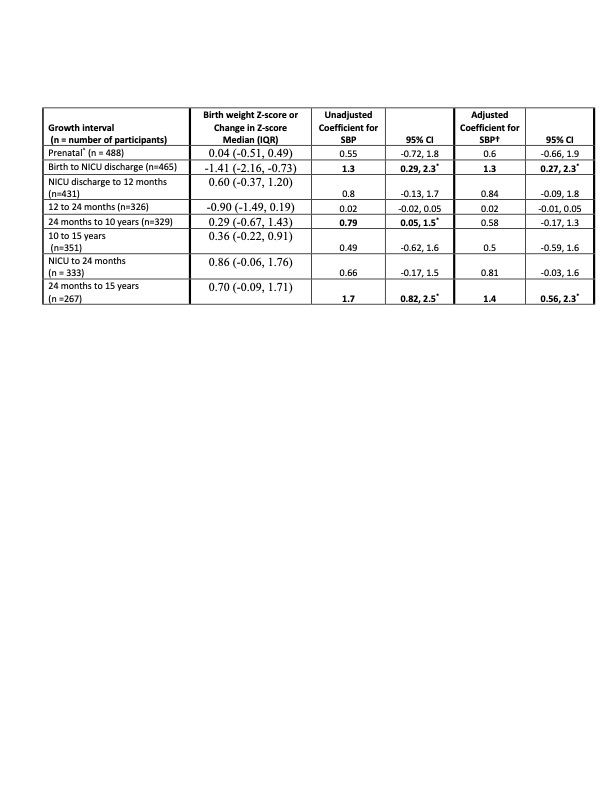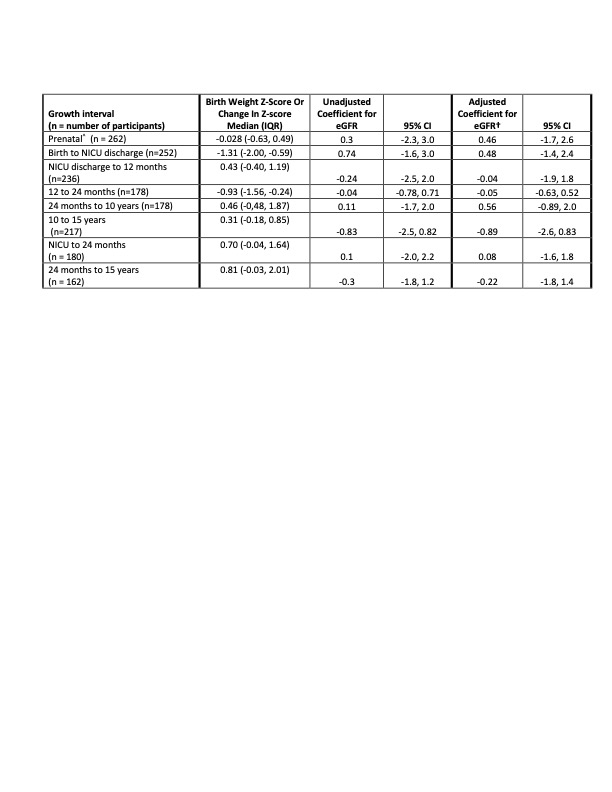Neonatology
Session: Neonatal Nephrology/AKI 2
52 - Growth Through Age 15 Years and Kidney Outcomes Among Adolescence Born Extremely Preterm
Sunday, May 5, 2024
3:30 PM - 6:00 PM ET
Poster Number: 52
Publication Number: 52.1718
Publication Number: 52.1718

Amalia Lee, MD, MPH (she/her/hers)
Neonatal-Perinatal Fellow
University of North Carolina at Chapel Hill School of Medicine
Chapel Hill, North Carolina, United States
Presenting Author(s)
Background: Prematurity and impaired fetal growth are linked to an increased risk of kidney dysfunction and chronic kidney disease. There is limited understanding of whether abnormal fetal and childhood growth among extremely premature infants contributes to this risk of kidney dysfunction.
Objective: To evaluate the association between pre and postnatal growth and markers of kidney dysfunction (elevated systolic blood pressure (SBP) and reduced estimated glomerular filtration rate (eGFR)) among adolescents born extremely preterm.
Design/Methods: Data were derived from a subset of individuals from the Extremely Low Gestational Age Newborn (ELGAN) study, a multicenter, prospective, observational study of infants born before 28 weeks gestation. For our analyses, 439 (58% of the cohort; 37% of survivors) assented to one or more kidney assessments.
Growth Exposure
Growth intervals were as follows: 1) birth weight z-score (prenatal) 2) change in weight z-scores from birth to discharge (growth during NICU admission), 3) change in weight z-score from discharge to 12 months and 12 months to 24 months (infancy), and 4) change in BMI z-score from 2 years to 10 years (early/middle childhood) and 10 years to 15 years (late childhood/adolescence).
Results: Multivariate linear regression model demonstrated no association between change in z-score in any growth interval and reduced eGFR in adolescence (Table 1). The change in weight z-score during NICU admission and the change in BMI z-score from 24 months to 15 years was associated with an increasing adolescent SBP (adjusted regression coefficient 1.3, 95% CI 0.27, 2.3 and 1.4, 95% CI 0.56, 2.3 respectively) (Table 2).
Conclusion(s): Among children born extremely premature, pre-natal growth was not associated with kidney dysfunction. Post-natal growth during NICU admission and between infancy and adolescence has an association with an increasing SBP in adolescence. This study suggests that SBP abnormalities may be the earlier sign of allostatic overload of nephrons in infants born extremely premature, while eGFR abnormalities may become more apparent beyond adolescence. Future studies are needed to evaluate interventions to support healthy growth rates and the impact on kidney function. Next steps, will include determining if these associations remain when analyzing variables as dichotomous with elevated SBP defined as > 95th percentile or >120/80mmHg or reduced eGFR defined as < 90mL/min/1.73m2. Additionally, performing sub-analyses to evaluate the association between the rate of growth (slow, rapid, and normal) and markers of kidney dysfunction.


